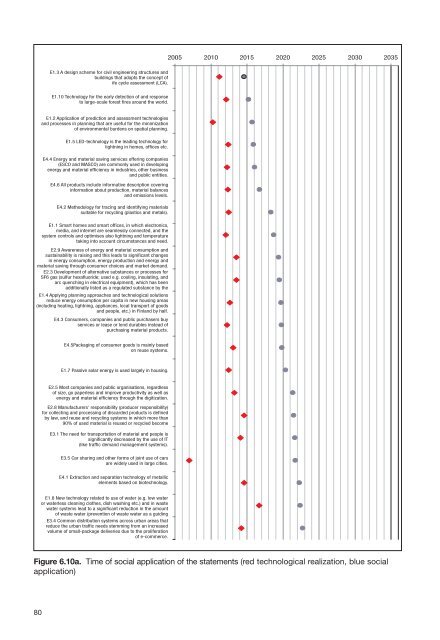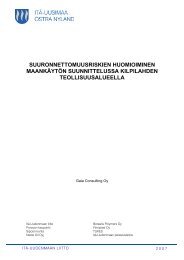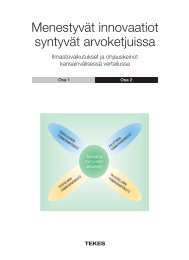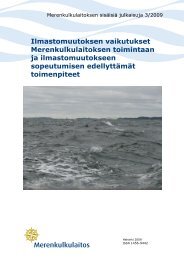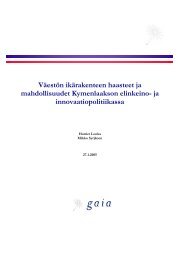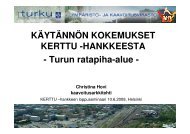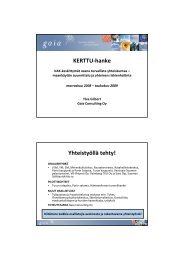227/08 Social challanges s the basis for foresight - Gaia
227/08 Social challanges s the basis for foresight - Gaia
227/08 Social challanges s the basis for foresight - Gaia
Create successful ePaper yourself
Turn your PDF publications into a flip-book with our unique Google optimized e-Paper software.
80<br />
E1.3 A design scheme <strong>for</strong> civil engineering structures and<br />
buildings that adopts <strong>the</strong> concept of<br />
ife cycle assessment (LCA).<br />
E1.10 Technology <strong>for</strong> <strong>the</strong> early detection of and response<br />
to large-scale <strong>for</strong>est fires around <strong>the</strong> world.<br />
E1.2 Application of prediction and assessment technologies<br />
and processes in planning that are useful <strong>for</strong> <strong>the</strong> minimization<br />
of environmental burdens on spatial planning.<br />
E1.5 LED-technology is <strong>the</strong> leading technology <strong>for</strong><br />
lightning in homes, offices etc.<br />
E4.4 Energy and material saving services offering companies<br />
(ESCO and MASCO) are commonly used in developing<br />
energy and material efficiency in industries, o<strong>the</strong>r business<br />
and public entities.<br />
E4.6 All products include in<strong>for</strong>mative description covering<br />
in<strong>for</strong>mation about production, material balances<br />
and emissions levels.<br />
E4.2 Methodology <strong>for</strong> tracing and identifying materials<br />
suitable <strong>for</strong> recycling (plastics and metals).<br />
E1.1 Smart homes and smart offices, in which electronics,<br />
media, and internet are seamlessly connected, and <strong>the</strong><br />
system controls and optimises also lightning and temperature<br />
taking into account circumstances and need.<br />
E2.9 Awareness of energy and material consumption and<br />
sustainability is raising and this leads to significant changes<br />
in energy consumption, energy production and energy and<br />
material saving through consumer choices and market demand.<br />
E2.3 Development of alternative substances or processes <strong>for</strong><br />
SF6 gas (sulfur hexafluoride; used e.g. cooling, insulating, and<br />
arc quenching in electrical equipment), which has been<br />
additionally listed as a regulated substance by <strong>the</strong><br />
E1.4 Applying planning approaches and technological solutions<br />
reduce energy onsumption per capita in new housing areas<br />
(including heating, lightning, appliances, local transport of goods<br />
and people, etc.) in Finland by half.<br />
E4.3 Consumers, companies and public purchasers buy<br />
services or lease or lend durables instead of<br />
purchasing material products.<br />
E4.5Packaging of consumer goods is mainly based<br />
on reuse systems.<br />
E1.7 Passive solar energy is used largely in housing.<br />
E2.5 Most companies and public organisations, regardless<br />
of size, go paperless and improve productivity as well as<br />
energy and material efficiency through <strong>the</strong> digitization.<br />
E2.8 Manufacturers' responsibility (producer responsibility)<br />
<strong>for</strong> collecting and processing of discarded products is defined<br />
by law, and reuse and recycling systems in which more than<br />
90% of used material is reused or recycled become<br />
E3.1 The need <strong>for</strong> transportation of material and people is<br />
significantly decreased by <strong>the</strong> use of IT<br />
(like traffic demand management systems).<br />
E3.5 Car sharing and o<strong>the</strong>r <strong>for</strong>ms of joint use of cars<br />
are widely used in large cities.<br />
E4.1 Extraction and separation technology of metallic<br />
elements based on biotechnology.<br />
E1.8 New technology related to use of water (e.g. low water<br />
or waterless cleaning clo<strong>the</strong>s, dish washing etc.) and in waste<br />
water systems lead to a significant reduction in <strong>the</strong> amount<br />
of waste water (prevention of waste water as a guiding<br />
E3.4 Common distribution systems across urban areas that<br />
reduce <strong>the</strong> urban traffic needs stemming from an increased<br />
volume of small-package deliveries due to <strong>the</strong> proliferation<br />
of e-commerce.<br />
2005 2010 2015 2020 2025 2030 2035<br />
Figure 6.10a. Time of social application of <strong>the</strong> statements (red technological realization, blue social<br />
application)


